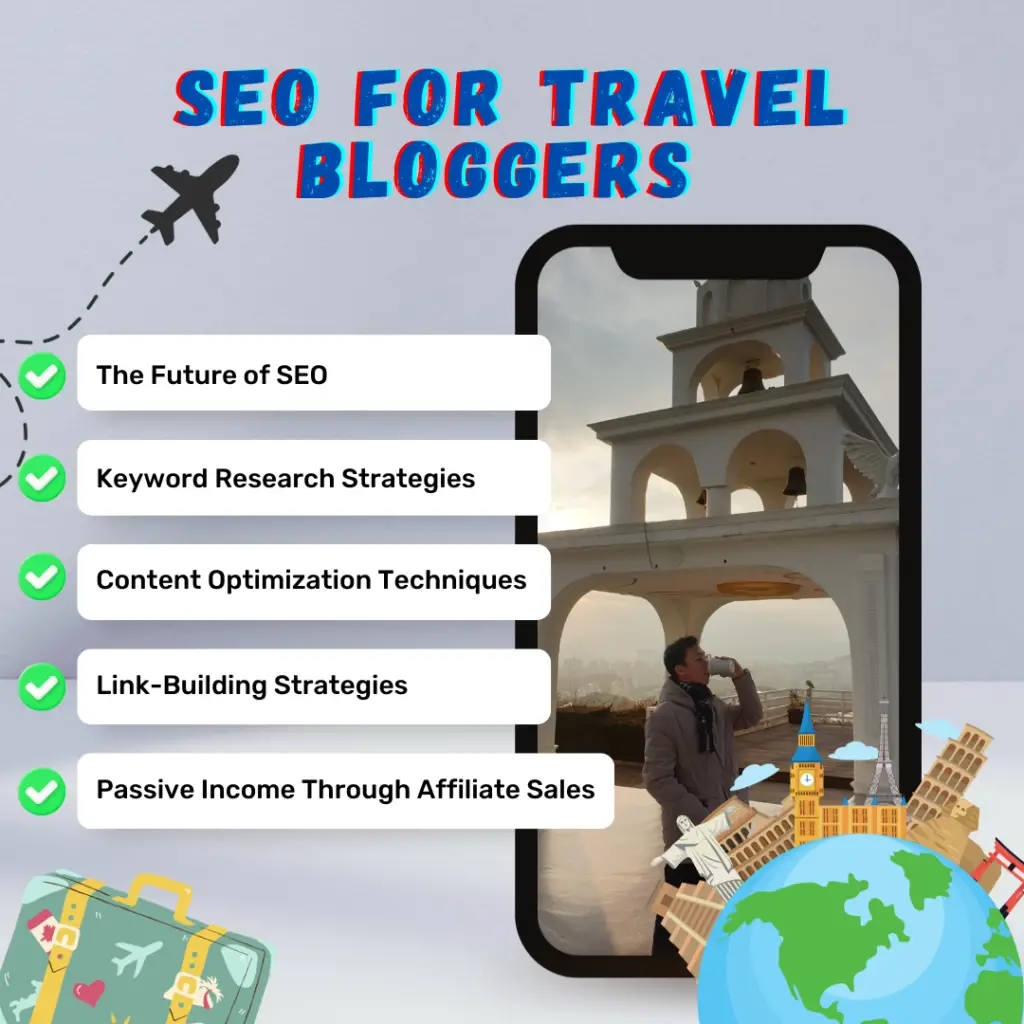SEO (search engine optimization) has changed dramatically over the last few years, travel bloggers need to stay ahead of the game to ensure their content reaches the right audience.
With new technologies and trends emerging, travel bloggers may need to adapt their SEO strategies for maximum visibility. This means keeping up with AI-driven content.
SEO for travel bloggers has changed dramatically as a result. Google is now looking for more juicy information, which means added video (e.g. podcasts, reels, YouTube content), less AI content written information, and more experience-driven writers to push content.
Some of us might dream of the digital nomad lifestyle. Well, I certainly did at one point, living for more than 15 days in tropical Bali. That was the day that I told myself the Bali lifestyle wasn’t for me. It’s too relaxing for me…😅

Hi, I’m Edmund; Founder of HustleVenture!
Over the last 3 years, I have been writing content about personal finance and side hustle. It took a while, but the website now has over 100,000 monthly visitors.
Could I retire as a writer? Certainly!
Over the last few years, the Internet has bred many up-and-coming digital nomads. Life behind the office desk seems to be phasing out as more remote opportunities are given to employees.
Apart from stock trading and working on side hustles, I do believe one of the most exciting ways of building an income stream is through blogging.
From ad revenue to affiliate sales to partnership and endorsement. There are many ways bloggers can make money on the Internet. However, it does require keeping up with the trend.
Over the last few years of blogging, I recently noticed the changes happening on both Google and YouTube. According to our research at HustleVenture, more than 60% of our readers prefer more illustrated content and word breaks in between. What this means is that readers are now having a shorter attention span in the ability to read than ever.
Blogging has evolved and I’ve noticed these 5 changes that have helped my blog 10x in growth, especially travel bloggers. If you are someone who is looking to work remotely anywhere with just your laptop and good Internet access (most important!), this article is packed with information and data.
Key Takeaways
- Understand the evolving search landscape to stay up-to-date with the latest trends and algorithms.
- Optimize for voice search by incorporating natural language and long-tail keywords into your content.
- Leverage artificial intelligence in SEO by using tools that can analyze data and provide insights for optimization.
- Embrace the rise of video content in travel blogging by creating engaging and informative videos.
- Identify long-tail keywords for niche travel topics to target specific audiences and improve search rankings.
The Future of SEO for Travel Bloggers

When I first started blogging over 10 years ago, it was almost an instant index for my blog. Fast forward to today, travel bloggers are now required to have keyword research tools that could cost upwards of $50 up to $999 per month (you know who I’m talking about!) just to research and write low-competition keywords to rank on Google.
Boy, that’s tough!
Understanding the Evolving Search Landscape
Search engine algorithms are becoming more sophisticated, placing a greater emphasis on user intent and context. This means that simply optimizing for keywords is no longer enough.
Travel bloggers need to focus on creating high-quality, relevant content that provides value to their audience more than ever.
To navigate the evolving search landscape, travel bloggers need to utilize data-driven insights such as Google Search Console, Ahrefs, MOZ, SEMRush, and other research tools. By analyzing search trends and user behavior, bloggers must be able to identify emerging topics and keywords that are relevant to their niche. This allows them to stay ahead of the competition and attract organic traffic to their blog.
Here’s what’s working before and what Google is looking out for in the future:
- Before – Images to represent information or keyword ➡️ Now – Reels and other sources to site your reels to push up on engagement
- Before – Short illustration to explain the experiences ➡️ Now – Longer breakdown content and actionable plans for readers to get something
- Before – Readers follow the brand and the author ➡️ Now – Readers retention on a blog for key information within the first 120 words
- Before – Readers will read to the conclusion ➡️ Now – Readers must gain a certain value or experience for at least 60 seconds
- Before – Many individuals wrote blog post style ➡️ Now – Businesses are almost in complete control of online content
The demand for quick reliable information has become a necessity to grow. With the rise of voice assistants like Siri and Alexa, more and more people are using voice commands to search for information. By optimizing their content for voice search, bloggers can improve their visibility and reach a wider audience.
Optimizing for Voice Search

As voice search continues to gain popularity, travel bloggers must optimize their content for this emerging trend. Voice search is changing the way people search for information, and travel bloggers need to adapt to ensure their content is discoverable. Here are some strategies to optimize for voice search:
- Use conversational language: When optimizing for voice search, it is important to use natural, conversational language in your content. This helps search engines understand and match user queries more effectively.
- Answer questions: Voice search queries often consist of questions. To optimize for voice search, consider including FAQ sections or dedicated sections that directly answer common questions related to your travel topics.
Tip: Keep your answers concise and to the point to provide quick and accurate responses to voice search queries.
- Optimize for featured snippets: Featured snippets are the concise answers that appear at the top of search engine results. Optimizing your content to appear as a featured snippet can increase your chances of being selected as the voice search result.
- Focus on mobile optimization: Voice search is heavily used on mobile devices. Ensure your website is mobile-friendly and loads quickly to provide a seamless experience for voice search users.
Leveraging Artificial Intelligence in SEO

You won’t be able to keep up with your writing if you don’t use AI.
Artificial Intelligence (AI) is revolutionizing the field of SEO for travel bloggers. I remember having to spend time reading, researching, and writing articles for 4~8 hours per day on 1 article. Fast forward to today with the help of AI, writing content will take about 2~3 hours max.
One of the key benefits of leveraging AI in SEO is the ability to analyze large amounts of data quickly and accurately. AI algorithms can identify patterns, trends, and user behavior to help bloggers understand what content resonates with their audience. Tools like AIPRM, Journalist AI, Jasper AI, and Writesonics are just some of the amazing content-writing AI tools that I use right now.
Keyword optimization is another area where AI can be highly effective and you need to implement it immediately. AI tools are used to analyze search queries and suggest relevant keywords that have high search volume and low competition. Here at HustleVenture, we use Ahrefs and SEMRush to do our keyword research and see the total keywords we rank for.
In addition to keyword optimization, AI can also help bloggers optimize their content structure. AI algorithms can analyze the structure of successful travel blog posts and provide recommendations on how to improve the organization and flow of content.
To make the most of AI in SEO, travel bloggers should consider using AI-powered tools and platforms that offer features such as content analysis, keyword research, and competitor analysis. These tools can save time and effort by automating repetitive tasks and providing valuable insights for optimizing content.
By leveraging AI in SEO, travel bloggers can stay ahead of the competition and ensure their content is optimized for maximum visibility and engagement.
The Rise of Video Content
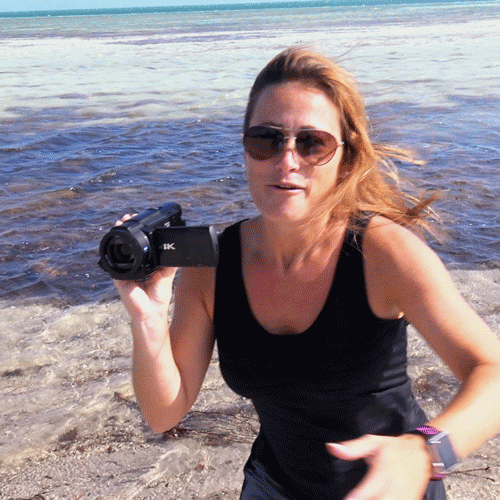
Video content has become increasingly popular in the travel blogging industry. Travel bloggers are now leveraging the power of visual storytelling to engage their audience and provide a more immersive experience. With the rise of platforms like YouTube and TikTok, video content has become a key component of a successful travel blog.
In addition to capturing the attention of viewers, video content also has the potential to improve SEO. Search engines like Google are placing more emphasis on video results in their search rankings. By optimizing video titles, descriptions, and tags with relevant keywords, travel bloggers can increase their visibility and attract more organic traffic.
To effectively incorporate video content into their travel blogs, bloggers should consider the following strategies:
- Create high-quality videos: Invest in good equipment and editing software to produce visually appealing and professional-looking videos.
- Tell compelling stories: Use storytelling techniques to captivate viewers and create an emotional connection.
- Optimize video metadata: Pay attention to video titles, descriptions, and tags to improve search visibility.
- Promote videos on social media: Share videos on platforms like Instagram, Facebook, and Twitter to reach a wider audience.
In conclusion, the rise of video content in travel blogging presents a valuable opportunity for travel bloggers to engage their audience and improve their SEO. By creating high-quality videos and optimizing video metadata, travel bloggers can enhance their visibility and attract more organic traffic.
Keyword Research Strategies

This is important. If you don’t have a strong social media following, knowing how to target keywords for SEO is your best bet.
Identifying Long-Tail Keywords for Niche Travel Topics
Long-tail keywords play a crucial role in driving targeted traffic to your travel blog. These keywords are more specific and have lower search volume compared to broad keywords. By targeting long-tail keywords, you can attract a highly engaged audience who are actively searching for niche travel topics.
FACT: Targeting long-tail keywords has a lower view count than evergreen keywords, but it’s a good technique to get yourself out there online. Build your online presence and people will start to follow the brand. To identify long-tail keywords for your travel blog, you can use various keyword research tools. Some popular options include:
Here’s a look at how to find long-tail keywords to write content for:
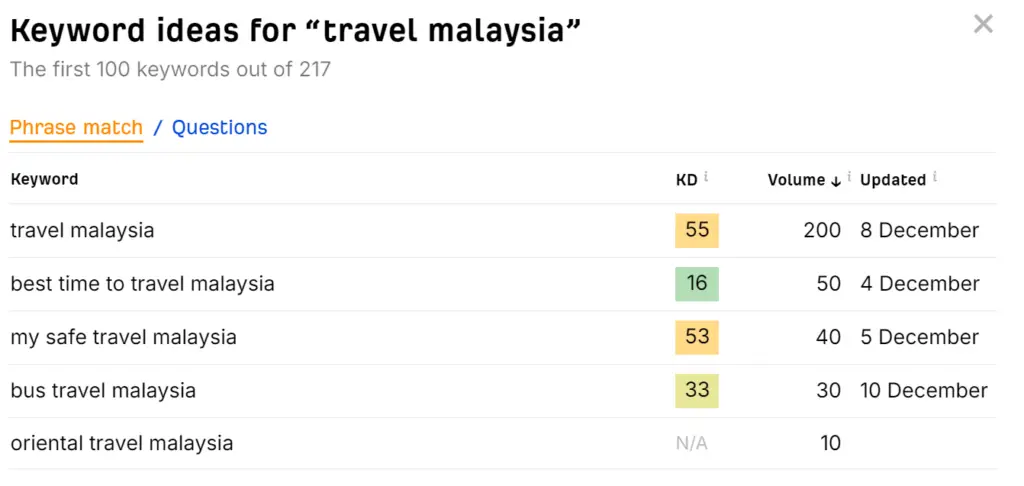
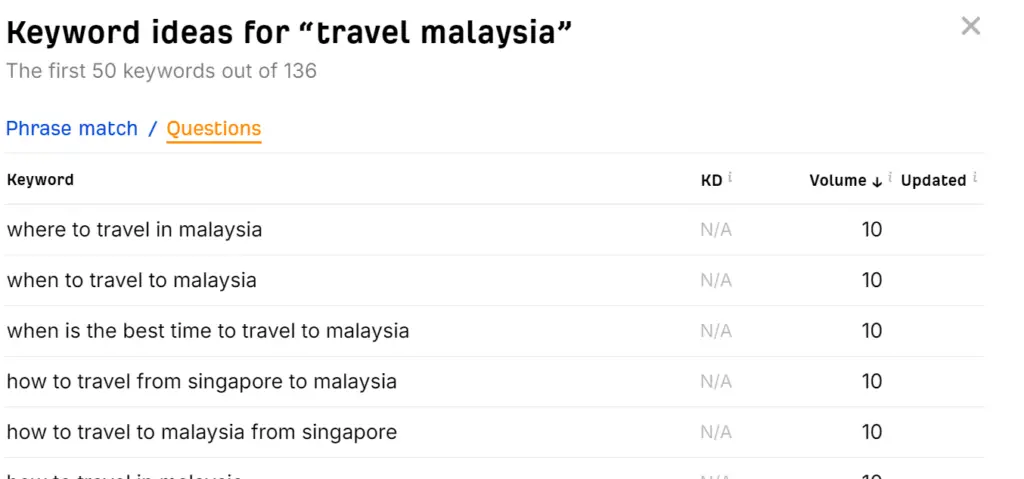
KD stands for keyword difficulty, the higher it is, the harder to rank.
When we search for keywords we want to rank for, its important to understand the complexity of ranking for certain keywords. If you are looking to rank for “travel Malaysia”, your best SEO strategy is targeting these long-tail keywords to build topical authority over this subject.
By analyzing the search volume and competition, you can find long-tail keywords that have a good balance of search traffic and low competition. Once you have identified relevant long-tail keywords, incorporate them naturally into your blog posts.
Remember to focus on providing valuable and informative content that aligns with the keywords. This will help improve your search rankings and attract organic traffic to your travel blog.
Using Trend Analysis Tools for Keyword Discovery
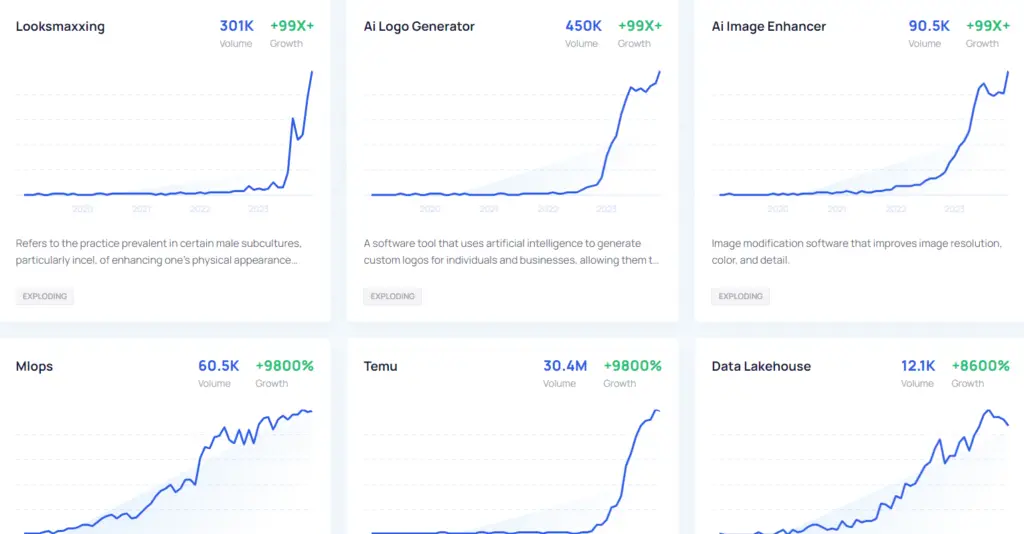
Trend analysis tools are invaluable for travel bloggers looking to stay ahead of the curve in SEO. These tools allow bloggers to identify emerging trends and popular topics in the travel industry, helping them create content that is relevant and engaging to their audience.
One effective way to use trend analysis tools is by monitoring keyword search volume over time. By tracking the popularity of specific keywords, bloggers can identify which topics are gaining traction and adjust their content strategy accordingly.
You could use either Google Trend or Exploding Topic to get your emerging keywords, I would highly recommend you to write this content ASAP since they typically have lower keyword difficulty and being the first-mover advantage seals you in as the authority in this field.
Competitor Analysis for Keyword Insights

Steal attention.
Identifying the keywords that your competitors are ranking for can help you understand the topics and themes that are popular in your niche. This information can guide your content creation and help you target similar keywords to attract your target audience.
When conducting competitor analysis, it’s important to analyze not only the keywords they are ranking for, but also the search volume and competition level of those keywords. This data can help you prioritize which keywords to target and determine the level of effort required to rank for them.
To organize and compare the keyword data from different competitors, you can use a Markdown table. This table can include columns for the competitor’s domain, the keywords they are ranking for, the search volume, and the competition level. By visually comparing this data, you can identify patterns and trends that can inform your own keyword strategy.
Optimizing for Local SEO in Travel Blogging

When it comes to optimizing for local SEO in travel blogging, there are several key strategies to consider. Local keywords play a crucial role in attracting targeted traffic to your blog.
Before you travel, conduct thorough research to identify relevant local keywords that align with your travel niche and incorporate them naturally into your content. Put at least 10~20 keywords that you can use for later for Google to pick up your content better.
Additionally, geotagging your blog posts and images can significantly improve your local SEO. By adding location-specific metadata to your content, search engines can better understand the geographical relevance of your blog and display it to users searching for travel information in that area.
To further enhance your local SEO, consider creating location-specific landing pages. These pages can target specific destinations or regions and provide valuable information for travelers. Optimize these pages with relevant keywords, high-quality content, and clear calls-to-action to improve your visibility in local search results.
Remember, consistency is key when optimizing for local SEO. Ensure that your business name, address, and phone number (NAP) are consistent across all platforms and directories. This helps search engines verify the legitimacy and credibility of your blog, improving your chances of ranking higher in local search results.
Content Optimization Techniques

Trend changes in Google ranking system. Your job is to update and make the content more relevant.
Creating Engaging and Shareable Travel Content
Creating engaging and shareable travel content is crucial for the success of a travel blogger. Engaging content captivates the readers and keeps them interested in your blog. It should be informative, entertaining, and provide value to the readers. Shareable content is content that people want to share with their friends and followers on social media platforms.
To create engaging and shareable travel content, consider the following techniques:
- Storytelling: Tell compelling stories about your travel experiences. Use vivid descriptions, personal anecdotes, and emotions to make your content more relatable and engaging.
- Visuals: Incorporate high-quality images and videos into your blog posts. Visual content is more likely to grab the attention of readers and encourage them to share your content.
- Interactive Elements: Include interactive elements such as quizzes, polls, and interactive maps to make your content more engaging and encourage reader participation.
Tip: Don’t be afraid to inject your personality into your content. Authenticity and uniqueness are key factors in creating engaging and shareable travel content.
Optimizing Meta Tags and Descriptions for SEO
When it comes to optimizing meta tags and descriptions for SEO, there are a few key strategies to keep in mind.
Firstly, it’s important to include relevant keywords in your meta tags and descriptions. Bold the most important keywords to make them stand out to search engines. Additionally, consider using italics for subtle emphasis on secondary keywords.
Next, ensure that your meta tags and descriptions accurately reflect the content of your page. This helps search engines understand what your page is about and improves the likelihood of it appearing in relevant search results.
To present structured data, you can utilize a Markdown table. This is particularly useful when presenting quantitative data, such as statistics or comparisons. Make sure the table is succinct and properly formatted in Markdown.
For less structured content, like a series of steps or related items, a bulleted or numbered list can be used. This makes the information easier to read and digest.
Lastly, here’s a quick tip: avoid using generic meta tags and descriptions. Instead, tailor them specifically to each page to maximize their effectiveness.
Utilizing Structured Data Markup for Rich Snippets
Structured data markup is a powerful tool that travel bloggers can use to enhance their search engine visibility and improve the appearance of their content in search results. By adding structured data markup to your travel blog posts, you can provide search engines with additional information about your content, such as the type of content, the author, the date published, and more.
One way to utilize structured data markup is by implementing a table to present structured, quantitative data. For example, if you have data about the top travel destinations in a specific region, you can create a table that showcases the destinations, their ratings, and other relevant information. This not only makes your content more organized and easy to read, but it also helps search engines understand the context of your content.
In addition to tables, you can also use bulleted or numbered lists to present less structured content. For instance, you can create a list of travel tips or a series of related items that are relevant to your travel blog post. Lists are a great way to break down information into digestible chunks and make it easier for readers to skim through your content.
Tip: When implementing structured data markup, make sure to follow the guidelines provided by search engines to ensure that your markup is valid and effective.
Implementing Mobile-Friendly Design for Better User Experience
In today’s digital landscape, having a mobile-friendly design is crucial for travel bloggers. With the increasing use of smartphones and tablets, it is important to ensure that your website is optimized for mobile devices. Responsive design is a key factor in providing a seamless user experience across different screen sizes.
One way to implement a mobile-friendly design is by using CSS media queries. These queries allow you to specify different styles for different screen sizes, ensuring that your website looks and functions well on mobile devices.
Another important aspect of mobile-friendly design is fast loading speed. Mobile users expect websites to load quickly, and a slow-loading website can lead to high bounce rates. To improve loading speed, optimize your images, minify CSS and JavaScript files, and leverage browser caching.
To further enhance the mobile user experience, consider implementing touch-friendly navigation. This includes using larger buttons and links, optimizing form inputs for touchscreens, and ensuring that the website is easy to navigate with a finger.
In summary, implementing a mobile-friendly design is essential for travel bloggers to provide a better user experience. By using responsive design, optimizing loading speed, and implementing touch-friendly navigation, you can ensure that your website is accessible and enjoyable for mobile users.
Link-Building Strategies

You want Google to view you as the leader in the space. To do that, other websites must write about you.
Building High-Quality Backlinks from Travel Websites
Building high-quality backlinks from travel websites is crucial for improving the search engine ranking of your travel blog. Backlinks are links from other websites that point to your blog, and they are considered as a vote of confidence in the quality and relevance of your content. Here are some strategies to help you build high-quality backlinks:
- Guest posting: Write guest posts for popular travel websites and include a link back to your blog in the author bio or within the content. This not only helps you get exposure to a wider audience but also earns you valuable backlinks.
- Collaborate with other travel bloggers: Reach out to other travel bloggers and collaborate on content. This can include co-writing articles, featuring each other’s blogs, or participating in interviews. By doing so, you can leverage their audience and earn backlinks from their websites.
Tip: When reaching out to other travel bloggers, make sure to personalize your message and explain how collaborating can benefit both parties.
- Participate in travel forums and communities: Engage in discussions and provide valuable insights in travel forums and communities. Include a link to your blog in your forum signature or when relevant to the discussion. This can help you establish yourself as an authority in the travel niche and earn backlinks from forum threads.
- Create valuable and shareable content: Focus on creating high-quality, informative, and engaging content that other travel websites would want to link to. This can include travel guides, destination reviews, tips and tricks, and unique experiences. When your content is valuable and shareable, other websites are more likely to link to it.
Tip: Conduct keyword research to identify popular topics and keywords in the travel niche, and optimize your content around those keywords.
By implementing these strategies, you can increase the number of high-quality backlinks to your travel blog, which in turn can improve your search engine ranking and drive more organic traffic to your website.
Guest Blogging for SEO and Brand Exposure
Guest blogging is a powerful strategy for SEO and brand exposure. By contributing high-quality content to other travel blogs, you can build backlinks to your own blog, which can improve your search engine rankings. Additionally, guest blogging allows you to expand your audience and establish yourself as an authority in the travel blogging community.
To make the most out of guest blogging, here are some tips:
- Research and identify travel blogs that are relevant to your niche and have a good domain authority. This will ensure that your guest posts are published on reputable websites.
- Craft compelling content that provides value to the readers of the host blog. Focus on sharing your expertise and unique insights to engage the audience.
- Include a bio at the end of your guest post with a link back to your own blog. This will drive traffic to your website and help with brand exposure.
Remember, guest blogging is not just about getting backlinks. It’s about building relationships, sharing knowledge, and contributing to the travel blogging community.
Utilizing Social Media for Link Building
Social media platforms are not just for sharing vacation photos and connecting with friends. They can also be powerful tools for link-building in the world of travel blogging. By strategically leveraging social media, travel bloggers can increase their website’s visibility, attract more traffic, and ultimately improve their search engine rankings.
One effective strategy is to actively engage with other travel bloggers and influencers on social media. By commenting on their posts, sharing their content, and building relationships, travel bloggers can create opportunities for collaborative link-building. This can involve guest blogging on each other’s websites, featuring each other in social media posts, or even co-creating content together.
Another way to utilize social media for link building is by promoting your own travel blog content. Share your blog posts, articles, and videos on social media platforms, and encourage your followers to visit your website and share your content with their networks. This can help generate natural backlinks as people discover and share your content.
In addition, social media platforms often have communities and groups dedicated to travel and blogging. Joining these communities and actively participating can provide opportunities to connect with other travel bloggers, share insights, and exchange links. It’s important to be genuine and contribute value to the community, rather than solely focusing on self-promotion.
To summarize, social media can be a valuable tool for travel bloggers to build links and improve their SEO. By engaging with other bloggers, promoting their own content, and participating in travel communities, bloggers can increase their website’s visibility and attract more organic traffic.
Earning Natural Links through Influencer Collaborations
Influencer collaborations can be a powerful way to earn natural links for your travel blog. By partnering with influencers in the travel industry, you can tap into their existing audience and gain exposure to a wider range of potential readers.
Here are some strategies to consider when collaborating with influencers:
- Identify relevant influencers: Look for influencers who have a strong presence in the travel niche and align with your brand values. This will ensure that their audience is interested in the content you provide.
- Create valuable content: Work with influencers to create high-quality content that provides value to their audience. This could be in the form of guest blog posts, social media collaborations, or video collaborations.
- Promote your collaboration: Once the content is created, promote it on your own platforms as well. This will help drive traffic to the influencer’s content and increase the chances of earning natural links.
- Build relationships: Building strong relationships with influencers is key to long-term success. Engage with their content, share their posts, and support their work. This will not only help you earn natural links but also establish you as a trusted and valuable partner.
Remember, when collaborating with influencers, it’s important to focus on creating genuine and authentic partnerships. This will not only benefit your SEO efforts but also enhance your overall brand image.
Earning Passive Income Through Affiliate Sales

Ready for the money-making portion?
99% of travel blogger fail their business before ever earning any affiliate sales. It’s sad to know that these people could have made it if they tried. Understandably, all these take time and not many are willing to sacrifice for the cause.
Many first-time business owners believe simply setting up a business would instantly gain credibility. I wish!
When it comes to setting up a travel blog and gaining influence, just know that Google pushes out your website content once it has gotten out of Google’s sandbox for at least 6 ~ 12 months. This is for Google to figure out what type of content you are putting out before it starts to rank your content.
Build Credibility in the Industry
To build creditability, you can’t simply write on your blog page. You will need to penetrate many other platforms.
For travel bloggers, they will need to use these platforms that can significantly grow their outreach:
- YouTube
- TikTok
Building your audience is great, just know that it takes time to build a credible portfolio before you can promote anything. You are more likely to buy from a friend than a salesperson, right?
Master the Art of Selling
Mastering the art of selling involves understanding your product and customer, building genuine relationships, and employing effective communication and persuasion techniques. Always prioritize listening to customers, addressing objections with confidence, and continuously learning from both successes and rejections. Embrace feedback, set clear goals, manage your time efficiently, and maintain a positive attitude. With dedication and adaptability, you’ll refine your sales skills over time and become a true master in the field.
![Steps to be a Professional Content Writer [ E-Book ]](https://hustleventuresg.com/wp-content/uploads/2023/04/Writing-3-642x1024.png)
Steps to be a Professional Content Writer [ E-Book ]
ready to be a Travel Blogger?
In conclusion, SEO continues to be a crucial aspect for travel bloggers in 2024. By implementing effective keyword strategies and following SEO best practices, bloggers can increase their visibility and attract more organic traffic to their travel blogs. It is important to stay updated with the latest SEO trends and adapt to the evolving search engine algorithms. Remember, content is king, so focus on creating high-quality and engaging content that resonates with your target audience. With the right SEO techniques, travel bloggers can enhance their online presence and establish themselves as authorities in the travel industry.
Frequently Asked Questions
What is the importance of SEO for travel bloggers?
SEO helps travel bloggers increase their visibility in search engine results, attract more organic traffic, and reach a larger audience. It is essential for driving targeted traffic to their website and gaining exposure for their travel content.
How can travel bloggers optimize for voice search?
To optimize for voice search, travel bloggers can focus on long-tail keywords, provide concise and direct answers to common travel-related questions, and ensure their website is mobile-friendly and loads quickly. Additionally, optimizing for local SEO can also help capture voice search queries related to specific destinations.
How can travel bloggers leverage artificial intelligence in SEO?
Travel bloggers can leverage artificial intelligence in SEO by using AI-powered tools for keyword research, content optimization, and data analysis. AI can help identify trends, analyze user behavior, and provide insights to improve the effectiveness of SEO strategies.
What role does video content play in travel blogging SEO?
Video content is becoming increasingly important in travel blogging SEO. It allows travel bloggers to engage their audience visually, showcase destinations and experiences, and improve user engagement metrics. Optimizing video titles, descriptions, and tags with relevant keywords can also help improve visibility in search results.
How can travel bloggers identify long-tail keywords for niche travel topics?
Travel bloggers can identify long-tail keywords for niche travel topics by conducting keyword research using tools like Google Keyword Planner, SEMrush, or Ahrefs. They can also analyze search queries related to their niche, explore forums and social media discussions, and monitor trending topics in the travel industry.
What is the benefit of optimizing for local SEO in travel blogging?
Optimizing for local SEO in travel blogging helps travel bloggers target specific locations and attract relevant traffic. It allows them to appear in local search results, capture local search intent, and increase visibility for travelers looking for information, recommendations, and guides related to specific destinations.

